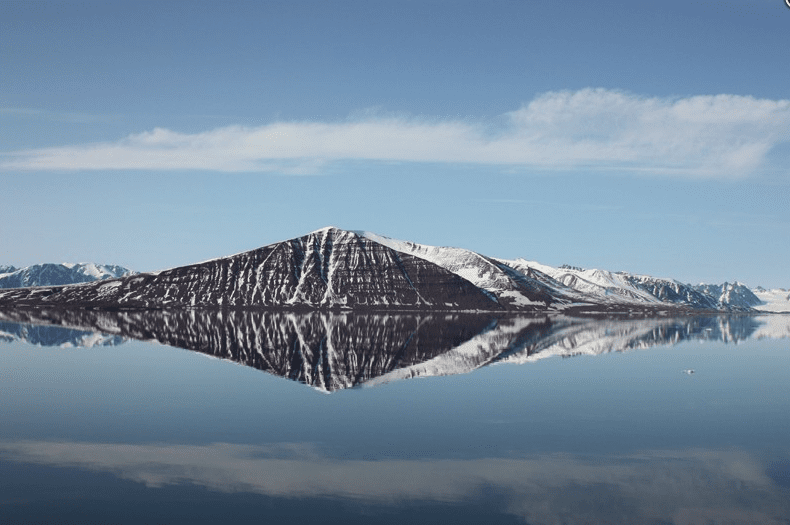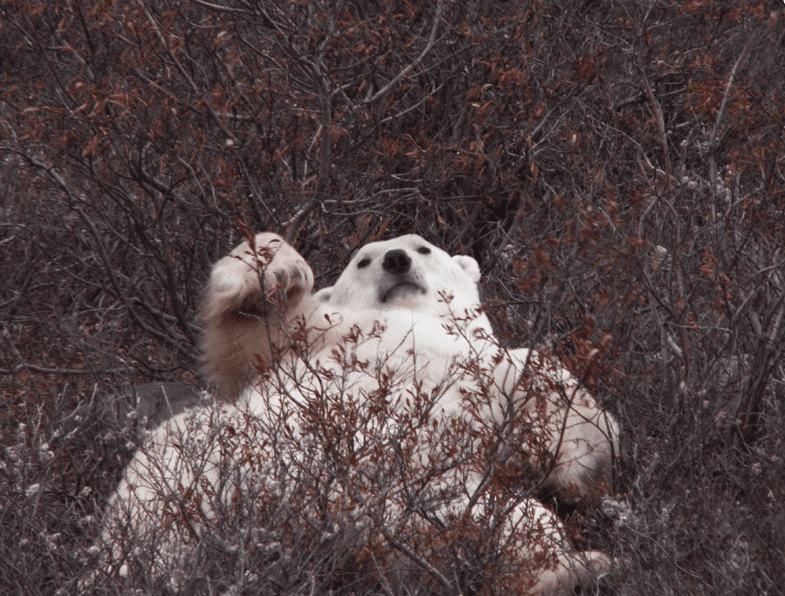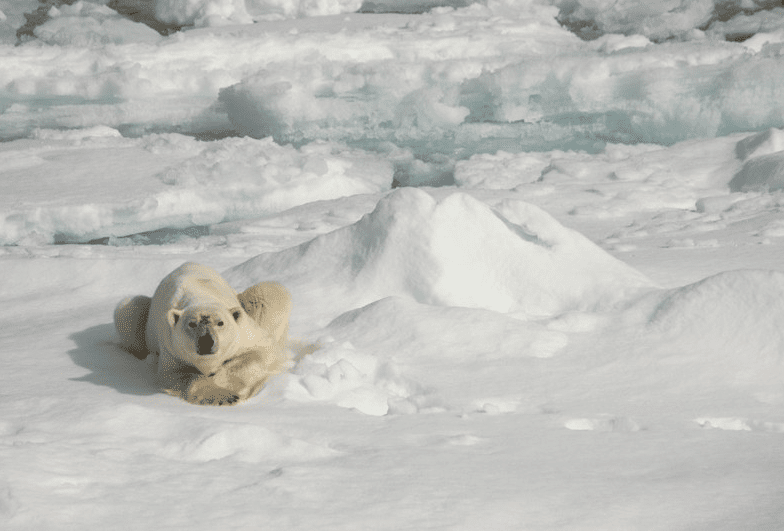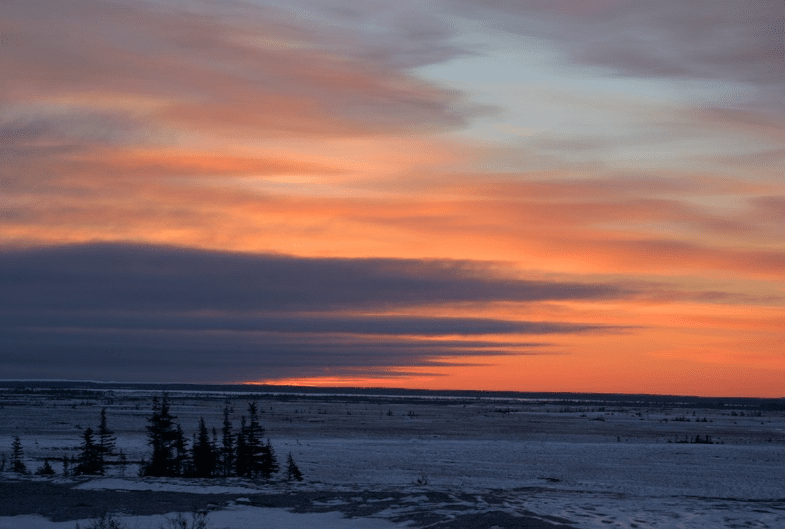North of 66° 33' latitude north, encompassing the top of our globe, infinite shades of blue, green, indigo and violet contrast the warm reflective glow of the sun's rays off the crystal waters, ice covered oceans and snow topped glaciers. The Great White North—the Arctic—is a land of tundra; treeless, and permanently frozen grounds, seemingly uninhabitable, dark jagged mountains dusted with soft snows casting prismatic colors, the lands mirroring the blue skies above. Yet, the vast icy landscape and cold crystal waters are home to a remarkable assortment of amazing creatures, a tightly connected ecosystem, from microscopic zooplankton that feed enormous whales, and small mouse-like voles that are prey to the arctic fox, to the seals that feed the world's largest carnivore, the polar bear.

Polar Bear
The word Arctic is derived from the Greek arktos meaning "bear," due the prominence of the constellation Ursa Major (Great Bear) in the northern night sky. And just as a great bear dominates the firmament above, so it does on the arctic ice below. The mighty polar bear is known for its immense proportions, with adult males weighing up to 1,500 lbs. Massive paws allow for weight distribution on thin ice and traction in the snow, a long snout creates the distinctive polar bear shape and houses an acute sense of smell; it's believed these predators can smell seals up to a mile away and under 3 feet of snow! Dark expressive eyes and a black nose stand out against the white fur. Polar bear fur, an amazing adaptation to keep the animal warm in the frigid arctic environment, is actually pigment free, hollow, and transparent, scattering the light to make them appear white, much like snow. In captivity, polar bears have been known to turn green due to the algae growth in their fur. The hollow strands trap air to maintain warmth. Their skin is black and covers a thick layer of fat that helps guard them against the freezing temperatures.
As the world's largest carnivore and land animal, polar bears are dependent on fish and seals for their diet. Hunting where ice meets the sea, polar bears are sometimes considered marine mammals, and their species name actually means "sea bear." These accomplished swimmers, using their massive forepaws as paddles, have been found swimming up to 200 miles from the coast in open ocean. Polar bears are not territorial and generally live solitary lives. Despite a fearsome reputation and solitary lifestyle, polar bears are known to congregate in large groups during the beginning of hunting season, and are described by a polar bear zoologist as having "well-developed friendships." The yearly polar bear gathering can be experienced in person by a polar cruise to Svalbard that brings you to the action with zodiac excursions along the coastline, or land adventures that park you in areas of high polar bear activity in the Tundra Lodge. Enjoy up close encounters as these curious creatures inspect your polar rover. Watch young bears play fight, see mothers snuggle with their cubs, and observe adults ambling across the tundra.
Whether exploring in a skiff, trekking through the jungle, or even enjoying a morning cup of coffee on the observation deck, wildlife abounds. During the day, we saw three-toed sloths lazily climbing trees, wooly monkeys jumping through the canopies, black-crested hawks stoically keeping watch over the river, and yellow-spotted turtles slipping into the water after sunbathing on small logs. At night, we spied the eyes of caimans just above the water and tiny frogs on the river’s edge.


Walrus
Another iconic animal of the Arctic is the walrus, which lives primarily in the shallow waters around the North Pole and Arctic Ocean, spending much of the time on the sea ice and in the waters below searching for mollusks to eat. Adult walruses are characterized by their prominent tusks, whiskers and their massive size, with male Pacific walruses reaching up to 3,700 lbs. The most well-known and conspicuous feature of the walrus is its long tusks, which are elongated canine teeth, visible in both male and female walruses. Tusks have an assortment of uses, from fighting and displays of dominance, to forming holes in the ice, aiding in hauling out of the water and allowing walruses to hang on the ice and keep their head above water. Generally, the male with the largest tusks is the leader of the herd.
The mustachioed appearance of the walrus is due to a collection of stiff bristles surrounding the tusks, known as vibrissae. The vibrissae are actually highly sensitive organs, attached to muscle and supplied with blood flow and nervous tissue. These whiskers allow the walrus to discriminate the shape and size of an object as it forages on the sea floor for mollusks. An air sac in the walrus' neck is another interesting anatomical feature. The sac can be inflated and used as a flotation device to keep the walrus' head above water as it bobs vertically and sleeps. Walruses are relatively long-lived, social animals, and they are considered to be a "keystone species" (an integral part of maintaining an ecosystem) of the Arctic marine regions due to their feeding habits effect on the productivity of shallow Arctic waters. These amazing animals can be witnessed in the wild by expedition cruises that visit known locations of walrus herds, such as Greenland and Baffin Island.
Arctic Fox
The arctic fox, also known as the white fox or polar fox, is a scrappy little animal well adapted to the frigid Arctic environment. Its puppy like features of small ears and muzzle (compared to other foxes) minimize heat loss. The large bushy tail aids in balance, but can also be used to wrap around its own body like a blanket. The arctic fox has a deep thick fur that changes color seasonally to provide camouflage: brown or grey in summer and white in winter to blend into the tundra landscape. This camouflage helps the fox effectively hunt small animals, including lemmings, seal pups, fish and bird eggs. With a keen sense of hearing, the arctic fox hears small prey such as voles and lemmings tunneling beneath the snow. It leaps into the air and pounces on the ground, breaking through the snow pack onto its prey below. As food is scarce in the winter months, the arctic fox has been known to follow in the tracks of polar bears to feed on the great bear's scraps. They will also eat plants including berries and seaweed. The arctic fox is found throughout the Arctic and is the only land mammal that is native to Iceland.
Muskox
Muskoxen, named for the musky odor emitted by males during mating season to attract females and the appearance similar to oxen, are closely related to sheep and goats. These prehistoric looking animals, with long curved horns and thick furry coat, were one of the few North American species to survive the last ice age. Their shaggy fur is reminiscent of the wooly mammoth, once a contemporary of the muskox. Muskoxen are occasionally domesticated for meat, milk and wool, which is highly prized for its softness, length, and insulation value. These wooly animals live primarily in Arctic Canada and Greenland.
Narwhal
The unicorn of the sea, the narwhal is a medium-sized toothed whale that lives year-round in the Arctic. The distinguishing feature of the male narwhal is a long, straight, helical tusk, actually an elongated upper left canine that grows directly through its upper lip. About one in 500 males has two tusks, which occurs when the right canine, normally small and less straight, also grows out. A female narwhal has a shorter and straighter tusk. Despite its formidable appearance and growing up to 9 feet long, the tusk is hollow and weighs only around 22lbs, and may be used as a sensory organ for detecting water pressure, salinity and temperature. Narwhals make some of the deepest dives ever recorded for a marine mammal, diving up to a mile beneath the water's surface. Found primarily in Canadian Arctic and Greenlandic waters, the narwhal is a uniquely specialized Arctic predator, feeding on a limited diet that includes squid and flatfish. This specialized diet, along with a narrow geographical range, makes them particularly vulnerable to the effects of climate change. These animals are a member of the toothed whale family, which includes dolphins and porpoises, and have large brains relative to their body size, second only to humans. This family of whales is also known to display humanlike behaviors, such as recognizing themselves in mirrors and grasping abstract ideas.
Beluga
Beluga whales, also known as white whales, are a close relative of the narwhal and live in the Arctic seas around the coasts of North America, Russia and Greenland. Highly sociable and playful, these creatures are referred to as the "sea canary" for their high pitch twittering. Noc, a beluga whale living in captivity, made news for the ability to mimic human speech patterns, not an easy feat for a beluga with a normal vocal range typically several octaves higher. Belugas demonstrate a great degree of curiosity towards humans in the wild, frequently swimming alongside boats. They play with objects found in the water such as wood, plants and bubbles. A highly developed sense of hearing and echolocation allow belugas to move about and find blowholes under sheet ice.
